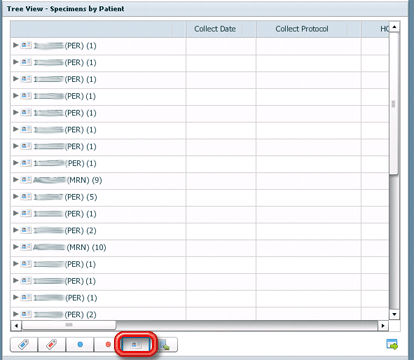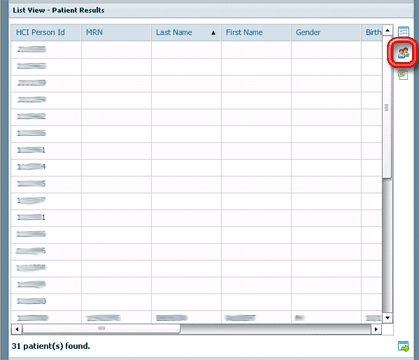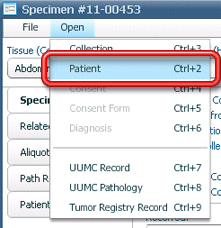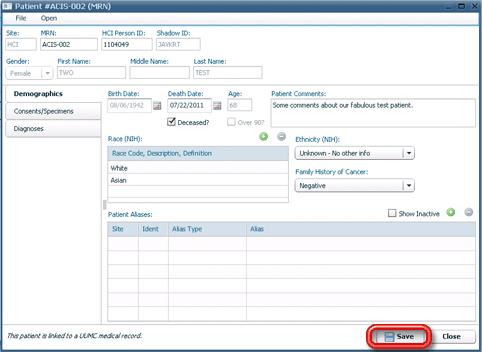- Welcome
- Use case
- Getting Started
-
Searching Records
- Performing a Basic Search
- Performing an Advanced Search
- Performing a List Search
- Performing a Keyword Search of UUMC Pathology Reports for all Patients in the Database
- Performing a Keyword Search of UUMC Pathology Reports for the Patients Associated with a Specific Set of Specimens
- Restrictions on Searches
- Reports
-
iQ Tool
- Adding Columns to a Query
- Starting the iQ Tool
- iQ Tool Window
- Current Query Data Group
- Saved Queries List
- Top Portion of the Selected
- Display or Report Columns Section
- Find/Filters Section
- Running a Preexisting Query
- Creating a Query
- Create Query Window
- Copying and Altering a Preexisting Query
- Removing Columns from a Query
- Editing Column Parameters in a Query
- Changing the Order of Columns in a Query
- Adding Filters to a Query
- Editing Filters in a Query
- Ways of Comparing Data
- Removing Filters From a Query
- Results Window
- Application Data Structure
- Application Database Fields Alphabetical List
- Application Datatree
- Field Paths List for the iQ Tool
-
Adding Specimens to the Database
- Adding a Single Specimen using the Add Specimen Wizard
- Adding a Batch of Specimens using the Add Specimen Expert Tool
- Saving a Batch of Specimens to be added as a Work in Progress
- Finishing a Work in Progress Batch
- Printing Barcodes for a Specimens in a Batch added using the Add Specimen Expert Tool
- Customizing the Add Specimen Expert Tool to Streamline Specimen Batch Entry
- Changing which Box an Add Expert Template Points for Adding Storage
- Importing FFPE Samples from UUMC
- Entering and Editing Specimen Records
- Transformations
- Specimen Disbursement and Registration
- Reports and Records
- Adding a Pathology Report to a Specimen Record
- Performing a DEXT Import of a Pathology Import
- Checking on the status of your DEXT Import Request
- Adding a Medical Record to a Specimen Record
- Editing Patient or Collection Records
- Editing Collection Records
- Editing Patient Records
- Diagnoses
- Adding a Diagnosis to a Patient Record
- Linking an Existing Diagnosis to one or more Collections
- Linking a Collection to a Diagnosis
- Recording a Consent for a Patient
- Reviewing a Patient's Consents
- Uploading a Patient's Consent Form
- Managing Patient Consents
- External (to itBioPath) Data Sources
- Managing Dictionaries
-
Storage
- Editing Aliquots
- Connecting a Barcode Label Printer to itBioPath
- Removing a Barcode Label Printer from itBioPath
- Freezer Management
- Viewing the Contents of a Box in a Freezer
- Accessing the Specimen Record for the Specimen associated with an Aliquot
- Editing Box Details
- Adding a New Box to a Freezer from the Add Aliquot Window
- Managing Protocols, Projects, and Related User Permissions
- Window, Tab, and Field Descriptions
- Miscellaneous
The results of any searches are specimens. You can also access the list of patients associated with those specimens by displaying these results grouped by patient or by accessing the patient results list. Patient data is data that applies to all specimens collected from the same patient, regardless of whether or not they were collected at the same time. It is kept in a patient record. Although some of it is displayed on collection and specimen records, you cannot edit patient data on either of these windows. Edit patient information on the Patient window. Any changes made to patient information will be reflected in all specimens associated with that patient. To access the patient record:
- Open the Patient window for the patient in question by doing one of the following:
- Perform a search using a patient alias, such as MRN as the only search criteria. Not only will all of that patient’s specimens be found, but the patient window for that patient will automatically open as well.
Or…
- Perform any search that results in at least one specimen from the patient in question being found — see Searching itBioPath Records for instructions on how to do this. After performing the search, do one of the following:
- In Tree View, click on the View specimens by patient button and double-click on the patient you want to edit in the list. Then, go to step 2 below. Or…

- Select List View, click on the Show Patient Results button and double-click on the patient you want to edit in the list. Then, go to step 2 below.

Or…
- Open a specimen record for a specimen that was collected from the patient in question and select Open-Patient from the menu bar at the top of the specimen window (or hit Ctrl+2).

- Make any needed changes to the patient record on the Patient window.
- Click
 to save your changes. The changes will be reflected on any and all specimen records for specimens associated with that patient.
to save your changes. The changes will be reflected on any and all specimen records for specimens associated with that patient.





